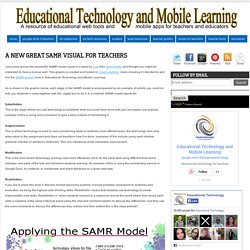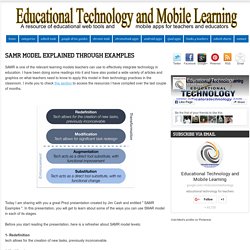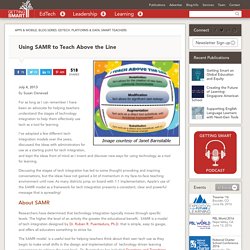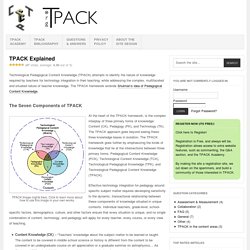

A Model for 21st Century Learning. Literacy with Information and Communication Technology (LwICT) means thinking critically and creatively, about information and about communication, as citizens of the global community, while using ICT responsibly and ethically.

A New Great SAMR Visual for Teachers. I just come across this wonderful SAMR model visual in a tweet by Lisa from TechChef4u and thought you might be interested to have a look as well.

This graphic is created and hosted in Cvkerr platform. Upon checking it I decided to add it to the SAMR section here in Educational Technology and Mobile Learning. As is shown in the graphic below, each stage in the SAMR model is accompanied by an example of activity you could do with you students in class together with the digital tool to do it.
In a nutshell, SAMR model stands for : Substitution This is the stage where you use technology to substitute what you could have done with pen and paper. one popular example of this is using word processor to type a story instead of handwriting it. Modification This is the level where technology is being used more effectively not to do the same task using different tools but to redesign new parts of the task and transform students learning. SAMR Model Explained Through Examples. SAMR is one of the relevant learning models teachers can use to effectively integrate technology in education.

I have been doing some readings into it and have also posted a wide variety of articles and graphics on what teachers need to know to apply this model in their technology practices in the classroom. I invite you to check this section to access the resources I have compiled over the last couple of months. Today I am sharing with you a great Prezi presentation created by Jim Cash and entitled " SAMR Examples ". In this presentation, you will get to learn about some of the ways you can use SMAR model in each of its stages. Before you start reading the presentation, here is a refresher about SAMR model levels: 1- Redefinition tech allows for the creation of new tasks, previously inconceivable. 2-Modification Technology allows for significant task design 3- Augmentation Technology acts as a direct tool substitute, with functional improvements. Using SAMR to Teach Above the Line - Getting Smart by Susan Oxnevad - 1:1 program, Apple, edchat, EdTech, SAMR, technology.
For as long as I can remember I have been an advocate for helping teachers understand the stages of technology integration to help them effectively use tech as a tool for learning.

I’ve adopted a few different tech integration models over the years, discussed the ideas with administrators for use as a starting point for tech integration, and kept the ideas front of mind as I invent and discover new ways for using technology as a tool for learning. Discussing the stages of tech integration has led to some thought provoking and inspiring conversations, but the ideas have not gained a lot of momentum in my face-to-face teaching environment until now. TPACK Explained. Technological Pedagogical Content Knowledge (TPACK) attempts to identify the nature of knowledge required by teachers for technology integration in their teaching, while addressing the complex, multifaceted and situated nature of teacher knowledge.

The TPACK framework extends Shulman’s idea of Pedagogical Content Knowledge. The Seven Components of TPACK TPACK Image (rights free). Click to learn more about how to use this image in your own works. At the heart of the TPACK framework, is the complex interplay of three primary forms of knowledge: Content (CK), Pedagogy (PK), and Technology (TK). Effective technology integration for pedagogy around specific subject matter requires developing sensitivity to the dynamic, transactional relationship between these components of knowledge situated in unique contexts.
Content Knowledge (CK) – “Teachers’ knowledge about the subject matter to be learned or taught. History and Ownership TPACK TPACK is not a brand new idea, nor is it owned by anyone. Using TPACK as a Framework for Tech PD, Integration and Assessment. Henrico County Schools System has adopted the TPACK as the Framework for professional development and 21st Century Learning in the Henrico County Schools System.

Henrico County is one of the largest and earliest districts to pioneer and implement a one-to-one initiative. They have adopted this model as its conceptual framework to guide their progress towards the 21st Century Learning. The following video will set the stage to provide insight into how this school district uses technology for relevant and real-world learning. See How Henrico County School District Incorporates Technology into Learning.Henrico 21 Overview from HCPS Instructional Technology on Vimeo. To see more videos visit this link. Below are some essential pieces toward meeting their vision. Www.tpack.org. Technology Integration Matrix. Technology Integration: The RAT – Replacement, Amplification, and Tra…